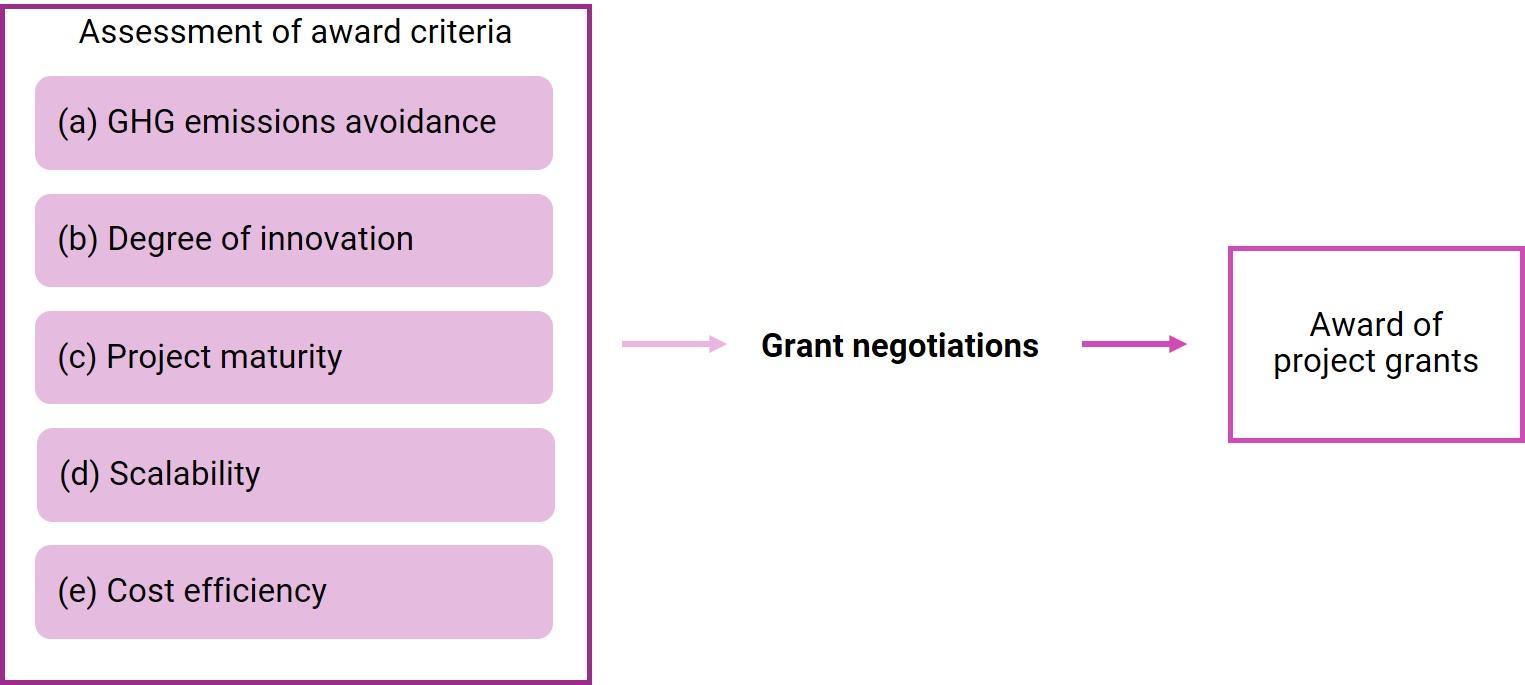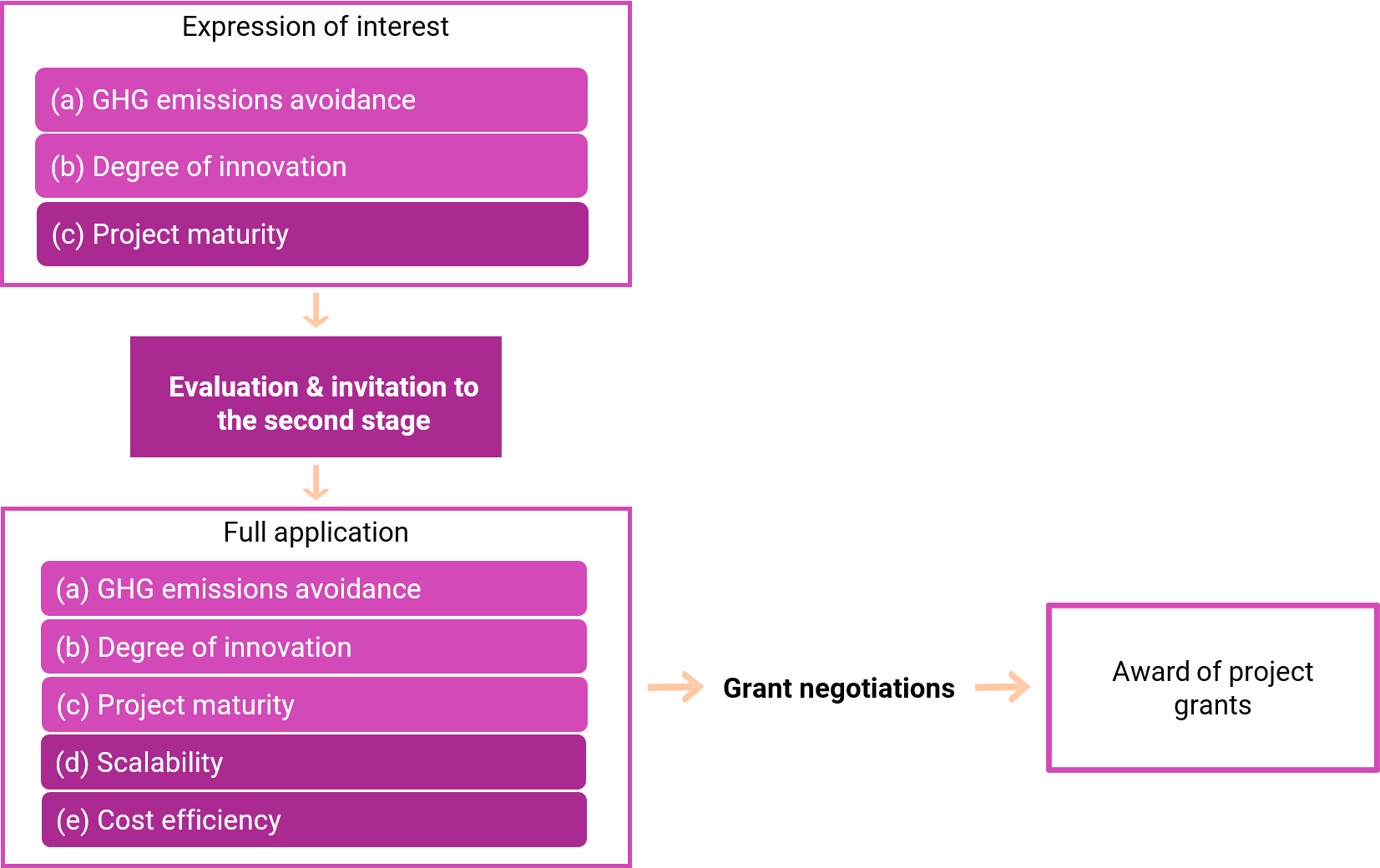Innovation Fund (small-scale)
| Quick facts | |
|---|---|
| Single applicant or multiparty | Both |
| Project duration | 3 years |
| Number of pages in the application | 70 pages |
| Maximum grant | EUR 4.5 million |
| Maximum capital expenditure of the project | EUR 7.5 million |
| Minimum capital expenditure of the project | EUR 2.5 million |
| Funding rate | Max. 60% of the capital costs |
| Type of application process | One-stage application |
| Supporting documents | Detailed calculation of GHG emission avoidance potential, Feasibility study and Business plan (max 100 pages all together for these 2 documents), detailed calculation of costs and cost-efficiency, list of relevant recent projects, profiles of key personnel |
Focus of the instrument
The small-scale Innovation Fund focuses on low-carbon technologies and processes in energy-intensive industries including products substituting carbon-intensive ones. It encourages environmentally safe carbon capture and utilization (CCU) and storage of carbon dioxide (CCS), as well as innovative renewable energy and energy storage technologies. This instrument aims at the first sale of new technology to pioneer customers.
What is funded?
This instrument funds activities that support innovation in low-carbon technologies and processes in emission trading sectors and replacement products. Annex I to the Emission Trading System (ETS) Directive provides a detailed list of eligible sectors.
Environmentally safe carbon capture and utilization can be funded if the capture of CO2 occurs within one of the listed activities, or if the utilization of CO2 results in products substituting carbon intensive ones from the listed sectors, even if carbon is captured outside the activities of Annex I.
Preparing the application
Application preparation takes approximately 3 months, depending on how detailed project plan the company already has. The application preparation also requires expertise on greenhouse gas (GHG) emission avoidance calculations. This can be outsourced to GHG consultant, if needed.
Evaluation
Project proposals are first evaluated against eligibility criteria and if the proposal fills the eligibility criteria, it will be evaluated against award criteria which are GHG emission avoidance, degree of innovation, project maturity, scalability and cost-efficiency. The given points for each criteria are between 0-5.
-
aGHG emission avoidance potentialApplicants have to provide a calculation for GHG emission avoidance which shows the absolute and relative GHG emission avoidance.
-
bDegree of InnovationThe evaluation determines the degree to which the project goes beyond incremental innovation on a scale from intermediate to breakthrough innovation. The project is assessed with regard to the following indicators related to climate-neutrality: energy efficiency, circularity, deployment of renewable electricity, potential to deliver net carbon removals.
-
cProject maturityProject maturity is assessed with the following three sub-criteria:
(1) Technical maturity to assess the degree of technology readiness and technical feasibility of achieving the GHG emissions avoidance.
(2) Financial maturity to assess the financial and business viability of the project, including credibility of the project business model, the financing plan, commitment of project funders.
(3) Operational maturity to assess the commercial deployment or demonstration of the project, including credibility of the project implementation plan, the project management/team, state of play and the proposed plan for obtaining required permits and intellectual property rights, the strategy for ensuring public acceptance, the strategy for securing the key supply and off-take contracts. -
dScalabilityScalability is assessed in accordance with the following three sub-criteria (1) Scalability at the level of the project and the regional economy, including plans for further expansion at project site and the possible technology transfer to other sites, cooperation with other actors of the regional economy, quality and extent of the knowledge-sharing plan. (2) Scalability at the level of the sector, including extent to which the technology of the project can be applied within the sector and the expected emissions avoidance, (3) Economy-wide scalability, including extent to which the technology of the project can be applied across the economy potential to create new value chains or reinforce existing ones.
-
eCost efficiencyThe call provides a separate calculation method for cost-efficiency. The idea is to show how efficiently expected the grant is used for creating GHG reductions.
Innovation Fund (large-scale)
| Quick facts | |
|---|---|
| Single applicant or multiparty | Both |
| Project duration | 10+ years |
| Type of application process | Two-stage application |
| Number of pages in the application (1st stage) | 40 pages |
| Maximum grant | No upper limit |
| Minimum capital expenditure of the project | EUR 7.5 million |
| Funding rate | Max. 60% of the relevant costs |
| Supporting documents for the 1st stage | Detailed calculation of GHG emission avoidance potential, Feasibility study 80 pages, Business plan 25 pages and Implementation plan 25 pages (all maximum page limits) |
Focus of the instrument
The instrument focuses on low-carbon technologies and processes in energy intensive industries including products substituting carbon intensive ones. It also emphasizes environmentally safe carbon capture (CCU) and utilization and storage of carbon dioxide (CCS), innovative renewable energy and energy storage technologies.
What is funded?
This instrument funds activities that support innovation in low-carbon technologies and processes in emission trading sectors and replacement products. Annex I to the Emission Trading System (ETS) Directive provides a detailed list of eligible sectors.
Also environmentally safe carbon capture and utilization can be funded if the capture of CO2 occurs within one of the listed activities, or if the utilization of CO2 results in products substituting carbon intensive ones from the listed sectors even if carbon is captured outside the activities of Annex I.
The focus of the large-scale Innovation Fund is on funding investments, in other words, establishing the first production plants. Development activities as such are not funded. Funded activities cover both capital expenditure (CAPEX) and operational expenditure (OPEX).
Furthermore, activities that help stimulate the construction and operation of projects that aim at the environmentally safe capture and geological storage of CO2 (CCS) are funded, as well as activities that help stimulate the construction and operation of innovative renewable energy and energy storage technologies.
Preparing the application
Application preparation in the first stage i.e. ”Expression of interest” takes approximately 4-5 months, depending on how detailed project
plan the company already has. The application preparation also requires expertise on greenhouse gas (GHG) emission avoidance calculations. This can be outsourced to GHG consultant, if needed.
Relevant costs
The relevant costs are the additional costs that are a result of the application of the innovative technology related to the reduction or avoidance of the greenhouse gas emissions. The relevant costs are calculated as the difference between the best estimate of the total capital expenditure, the net present value of operating costs and benefits arising during 10 years after the entry into operation of the project compared to the result of the same calculation for a conventional production with the same capacity in terms of effective production of the respective final product. Where the conventional production does not exist, the relevant costs are the best estimate of the total capital expenditure and the net present value of operating costs and benefits arising during 10 years after the entry into operation of the project.
In principle, the relevant costs represent the difference between project’s production costs and reference scenario of 10 years.
Evaluation
Project proposals are first evaluated against eligibility criteria and if the proposal fills the eligibility criteria, it will be evaluated against award criteria which are GHG emission avoidance, degree of innovation and project maturity.
If the project is among the best ones in the first stage i.e. “Expression of interest”, it is entitled to submit a more detailed project proposal in the second stage i.e. “Full application”. The award criteria in the second stage are GHG emission avoidance, degree of innovation, project maturity, scalability, and cost-efficiency (see small-scale evaluation above). The given points for each criteria in both stages are between 0-5.


